Fodsports FX 60C vs FX30C Pro: What's new techs are the FX 60C bringing to us? Fodsports is a brand worth-mention for helmet communication and video recording. This brand has established itself as a key player with its innovative Bluetooth camera intercom systems. Recently, Fodsports has released a new camera intercom, the FX 60C. How […]
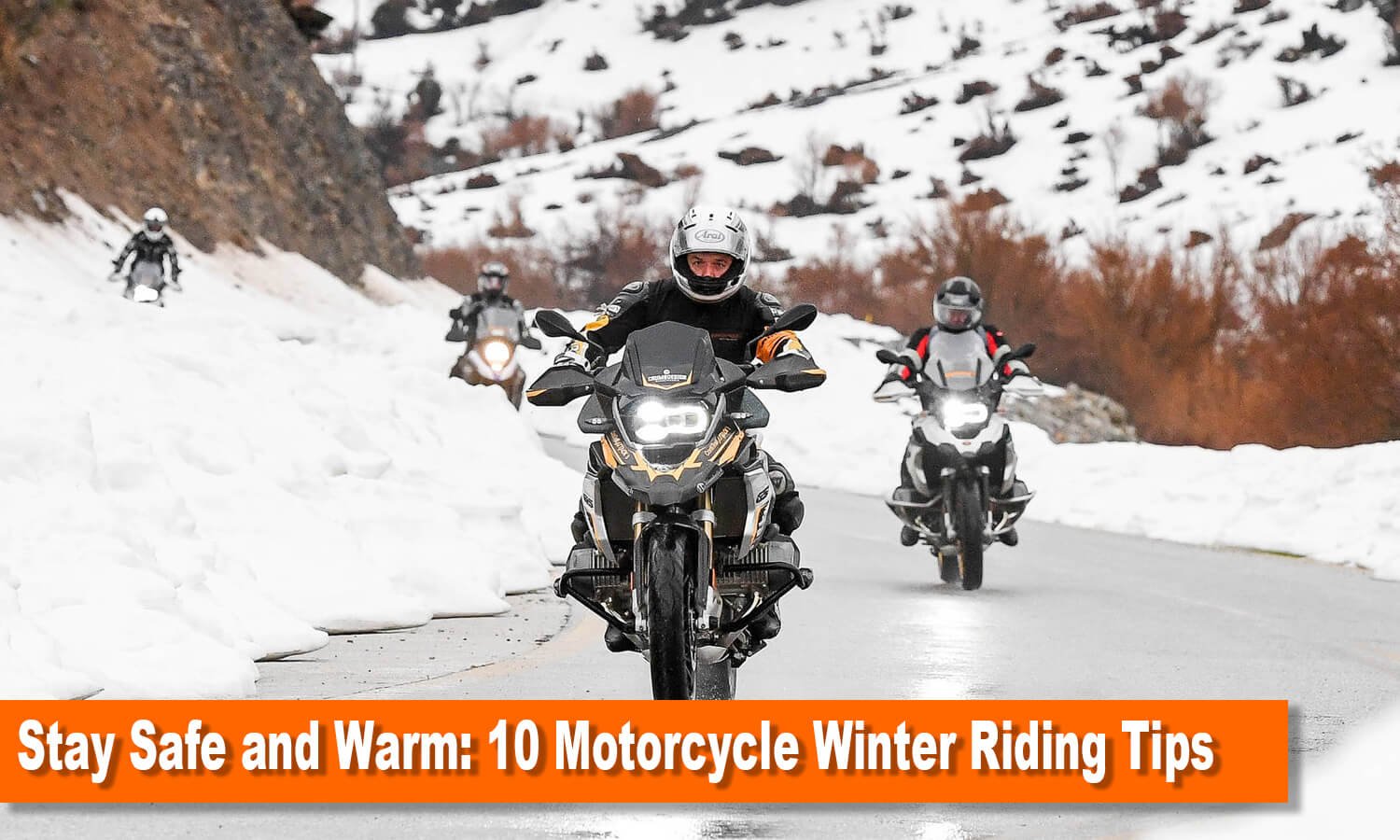
10 Motorcycle Winter Riding Tips: Stay Safe and Warm 2024
Winter is approaching, and for most riders, the riding season is coming to an end. But there are motorcycle enthusiasts and people who need motorcycle commuting who still need to ride during these cold days.
Some riders may find it an exciting experience to ride a motorcycle in winter. But, for most riders, motorcycle winter riding is a unique challenge.
There are many aspects of riding a motorcycle in winter that are different from other riding seasons, besides the cold you will feel.
Cold air, snow, and other winter weather conditions will have a significant impact on your motorcycle and you personally.
Therefore, it is necessary to be well-prepared and exercise caution before setting out on a winter ride. Some essential accessories and gear will help you extend your ride in the cold months.
Whether you are an experienced rider or a winter riding novice, you will get something in this blog. This guide will provide you with the necessary motorcycle winter riding tips to ensure a safe and enjoyable trip.
Table of Contents
Motorcycle Winter Riding Tips
#1. Prepare your motorcycle

Check your motorcycle and get it prepared - motorcycle winter riding tips
Check your tires
Winter riding can be slippery or icy, so make sure your motorcycle tires have excellent traction. Only if your tires have enough tread depth can you safely handle slippery and icy roads.
Winter tires for motorcycles are currently available in many online and offline stores. You may consider replacing your motorcycle with these special tires in winter. They can provide better grip in cold and slippery road conditions.
Besides, check the tire pressure before you go, making sure the pressure is normal and good to go.
Battery Health
Cold weather will drain your motorcycle battery faster than usual. Therefore, it is necessary to check the battery charge and condition regularly.
At the same time, the endurance of motorcycle batteries will also decrease in winter. If you are about to embark on a long-distance ride, it is important to charge the battery before departure. And you should also pay attention to the battery life during the journey.
In addition, when the motorcycle is not in use, carry a battery charger with you to maintain the power. Do not leave the battery in a depleted state for a long time, which will damage the battery and shorten its life.
Fluid Levels
Check all fluid levels, including oil, coolant, and brake fluid before you start the winter ride.
Use winter-grade oil to ensure smooth engine operation in cold temperatures. This kind of oil can protect and help your motorcycle start and run in cold weather.
Besides, ensure the coolant is rated for below-freezing temperatures to prevent engine damage.
How to Change Motorcycle Coolant? How Often Should You Replace Motorcycle Coolant?
Lighting
Visibility is often reduced in winter due to shorter days and adverse weather conditions. So, lighting check is also an important winter motorcycle riding tip.
Check and make sure all lights are functioning correctly. These include the headlights, brake lights, turn signals, daytime running lights, fog lights, and others.
If you think the light is not bright enough, you can consider upgrading to LED bulbs for brighter output.
Lubricate Moving Parts
Cold weather can cause parts to stiffen. Keep your chain and other moving parts well-lubricated to ensure smooth operation. Check and adjust lubrication more frequently than in warmer months.
#2. Dress for the Weather to Stay Warm
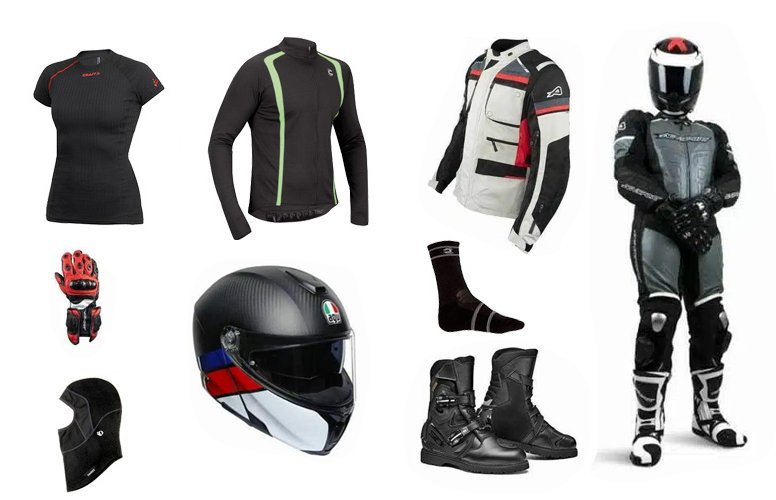
essential motorcycle winter riding dress to stay warm
Layer Up
Wearing multiple layers is key to staying warm, but you need to choose gear that fits you well but isn’t too tight.
Clothing that is breathable and has room for airflow and can be layered is your first choice.
Wear a moisture-wicking base layer first, then an insulating mid layer, and finally a waterproof and windproof outer layer.
This combination helps regulate your body temperature and keep you dry.
At this point, we can’t stress enough how important waterproof and windproof gear is for winter riding. Waterproof and windproof gear will protect your body from getting wet or freezing cold in the cold winter.
Remember, even if there’s no rain, snow, or extreme weather when you set out, bring these cold-weather clothing. Once you’re in these extreme conditions, they’ll keep your body warm.
Trust me, this winter motorcycle riding tip will always benefit you.
Heated Gear
Buying heated gear like gloves, vests, and grips is also a necessary winter riding tip. These gears are especially useful for maintaining body temperature during long rides.
I love using heated gloves and heated grips because they keep my hands warm. You know, this will help your hands better control the motorcycle handlebars. If your hands are cold, you can't even grip the handlebars and control the motorcycle properly.
Also, when buying these gears, you need to pay attention to the configuration of your motorcycle. Make sure your motorcycle can handle the electrical load of the heating gear.
Good boots
Hands need protection because they control the handlebars of the motorcycle, your feet also need good protection.
When your feet are cold and numb, you will be affected when you step on the clutch, shift gears and brake.
I think you should be aware of this danger, but I would rather you never experience these unhappy moments.
Thus, wearing warm, waterproof and grippy boots is your best choice when riding in winter.
Not know how to choose the right boots for your next ride? Read here.
Balaclava and neck warmer
Balaclava or neck warmer can protect your face and neck from cold wind. These items help seal the gap between the helmet and jacket to prevent wind chill. Wearing these equipment will prevent the cold wind from entering your helmet and jacket, so your body will not feel cold.
Choose a full-face helmet
In the freezing winter, wearing a full face helmet must be your first choice. It will fully protect your face and head, preventing the cold wind from making your head cold or even causing a cold.
Pair your full-face helmet with a neck warmer will bring you better effect. They will block the gap between the helmet and the jacket, and the cold air and wind will not be able to sneak in and get close to your body.
#3. Equip Essential Motorcycle Winter Riding Gear
Another winter motorcycle safety tip is to prepare your cold-weather riding gear. Unlike summer riding, winter riding requires some additional equipment.
Thermos
Drink a sip of warm water when you stop to rest during a winter ride. So, prepare a thermo so that you can bring warm water when riding in winter. It will help your body maintain its core temperature and prevent hypothermia.
Drinking warm water can also increase blood circulation slightly, which can help provide warmth to your cold extremities (such as fingers and toes).
Hand warmers
Hand warmers are also a good choice. They can help warm your hands. You can buy a small hand warmer, add hot water and put it into your large windproof gloves before going out. Most hand warmers can maintain temperature for several hours.
Snacks
In the winter, you need more calories to maintain body temperature, especially when riding in the winter. It is best to carry some small but high-calorie snacks such as chocolate, candy, beef jerky, nuts, etc. These small snacks can quickly replenish energy and keep you energetic and focused on riding.
Helmet communication system
Choose a waterproof motorcycle helmet communication system to keep you connected in the winter. For example, the Fodsports FX7, a Bluetooth mesh intercom with IP67 waterproof level, will be a perfect choice.
On one hand, they can achieve real-time smooth voice communication when you ride in a group. Thus making your ride more convenient and safer.
On the other hand, they can also connect with the voice assistant of the smartphone and smoothly make calls, listen to music or use other functions on the phone.
You don't need to take out your hands from your clothes to take out your phone and stand in the cold wind shivering to operate the phone.
Purchase Motorcycle Helmet Communication System to Improve Riding Safety
#4. Add Wind Protection Device

add wind protection device to minimize cold airflow
Lowers
Adding lowers to your motorcycle can help block some of the cold wind, rain, and snow.
It mainly provides wind and mud protection for the rider's legs and boots. This can minimize cold airflow and prevent your legs and feet from being frozen by the constant invasion of cold airflow.
When choosing lowers, be sure to choose one that matches the shape of your motorcycle.
Some motorcycle equipment shops can provide custom services to make the lowers fit the engine guard perfectly, thereby minimizing the shaking during riding.
Windshield
The windshield is another device worth equipping for winter motorcycle riding.
Because different motorcycle model has a different shape, there are also various windshields.
Installing a quick-release removable windshield will be the best choice. They can provide the most fashion sense and function.
And, when the temperature rises and the warm season arrives, you can also remove it and store it for use next winter.
Remember to clean the windshield before you store it for long time.
#5. Ride Smart
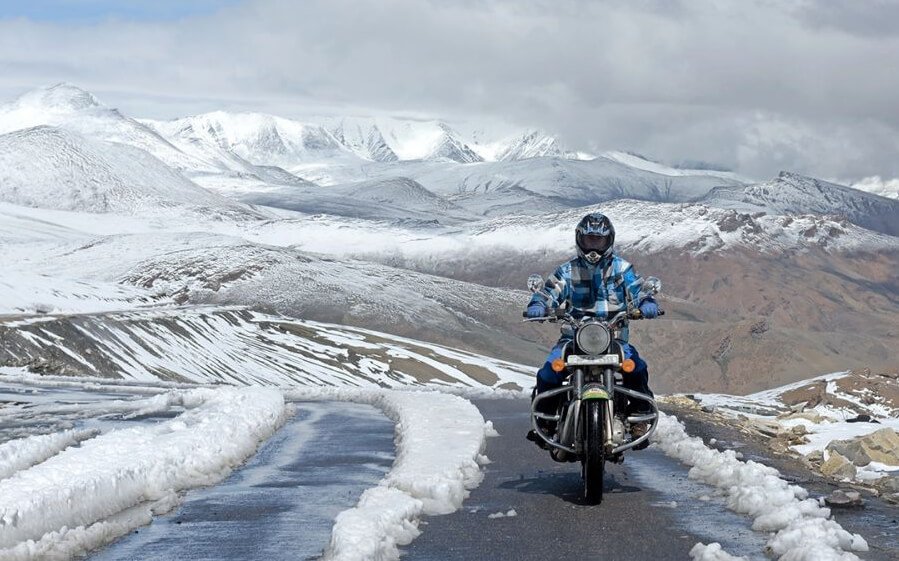
motorcycle winter ride tips - ride smartly
Adjust Riding Style
Winter riding requires a more cautious approach than other riding seasons. Therefore, adjust your riding style will be a smart winter motorcycle riding tip.
Remember to increase your motorcycle following distance when riding in winter. You will get more time to react to slippery conditions.
What's more, you should avoid sudden acceleration and braking, and make turns slowly to prevent skidding.
Be Aware of Road Conditions
Stay informed about the weather and road conditions before heading out.
Look out for black ice, which can be nearly invisible but extremely slippery.
And, you should avoid riding immediately after a snowfall until the roads are cleared.
Use Caution on Bridges and Overpasses
These structures freeze faster than regular roads due to airflow underneath.
So, remember to approach them with caution and avoid sudden movements. Otherwise could lead to a loss of traction.
Avoid Riding in Extreme Conditions
If conditions are too severe, consider postponing your ride.
Heavy snow, ice storms, and rainy days increase the risk of accidents and mechanical failures.
In the extremely low temperature and heavey wind days, cancel the ride is also a wise choice.
#6. Stay Your Motorcycle Visible

add reflective tape onto your motorcycle can also improve its visibility
Bright Clothing
Wear bright or reflective clothing can also enhance you and your motorcycle's visibility. This is crucial in winter when daylight is limited and adverse weather can reduce visibility even further.
Use Reflective Tape
Add reflective tape to your motorcycle and gear. This simple addition can significantly improve your visibility to other drivers. These tapes will be especially helpful in low-light conditions.
#7. Ride in a Group
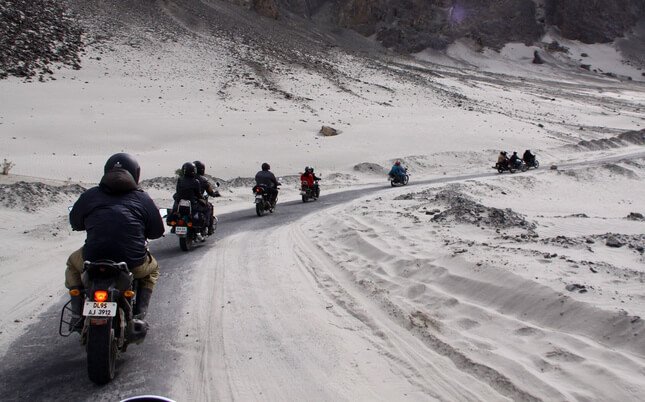
riders are ride in group in winter
Group riding will be one of the perfect motorcycle winter riding tips. Compared with other seasons, winter have more safety factors such as low temperature, rain, snow, ice, and slippery roads.
Riding with a group of friends will greatly increase the safety of winter motorcycle riding. When you ride together, use motorcycle intercoms that supports group communication. It will bring more safety and smooth communication to your rides.
When there is a problem on the road ahead or around you, you can communicate in real time through the intercom. Multiple pairs of eyes in the riding group will be able to foresee various unsafe factors earlier.
Or, when one of you needs help, you can also call your teammates through group intercom.
Fodsports FX8 Pro, Fodsports M1-S Plus and Fodsports FX8 are the best options for group communication. They can be easily installed on the helmet, and through one-click quick pairing, you can talk to other riders, share music or make calls. The FX8 Pro can even support listening to music while intercom, making your winter ride more enjoyable.
Use Fodsports Group Intercom to Enhance Group Ride Communication
#8. Maintain Your Riding Skills
First of all, if you are a novice rider, we do not recommend riding in winter unless you have to. Because most novice riders who have been riding for less than a year have no experience riding in winter. If you ride on the road rashly, it is easy to cause safety accidents.
Of course, for experienced riders, don't take it lightly and let your guard down. Before riding in winter, you also need to practice to find the feeling you had when riding last winter.
Pay attention to vigilance
When riding in winter, drivers are more likely to be distracted. Besides, weather such as rain, snow, and fog will also affect your vision. Thus, riders need to be more focused and be aware of the blind spots of both yours and other vehicles.
Increase the distance between vehicles
Increasing the distance between you and other vehicles is one of the important winter motorcycle riding safety tips. Because in winter, you and other vehicles need more vision and braking distance than in other seasons.
Practice in a safe area
If you are a novice in winter riding, practice in a safe, controlled environment before heading to busy roads. Parking lots or quiet streets are ideal places to get familiar with different handling characteristics.
And, if you live in an area where there are snow and ice in the winter, you also need to be familiar with some snow and ice riding techniques. Because snow and ice riding techniques are still different from typical winter riding.
Take a winter riding course
If you are a novice, you can also consider signing up for a winter riding course. There, professional instructors will teach you a wealth of winter motorcycle riding tips.
These courses provide valuable skills for handling the bike in cold and slippery conditions, which can enhance your confidence and safety.
#9. Stay Connected
When riding in the winter, always make sure you can contact your family and friends. If an accident occurs, cold weather can make it more difficult to help, such as delaying the arrival of rescue forces.
Carry a fully charged phone
Always carry a fully charged phone with you in case of an emergency. If riding for longer periods of time, consider carrying a portable charger. These will ensure that you can call for help if needed.
Tell others about your route
Tell your family or friends about your planned route and estimated time of arrival. This way, if there is a problem, they can notify the authorities of your location.
#10. Prepare for Emergencies
Prepare an emergency kit
Carry an emergency kit that includes items such as a flashlight, first aid supplies, spare fuses, and basic tools.
In addition, you may need to pack extra cold weather gear because of the colder winter temperatures. Include a thermal blanket and some non-perishable snacks in case you get stranded.
Know basic repairs
Being familiar with basic motorcycle repairs is a good idea. Knowing how to fix a flat tire or jump-start your battery is useful if you run into problems on the trail. Otherwise, it can be dangerous to get stuck with your motorcycle in the snow during extreme winter weather.
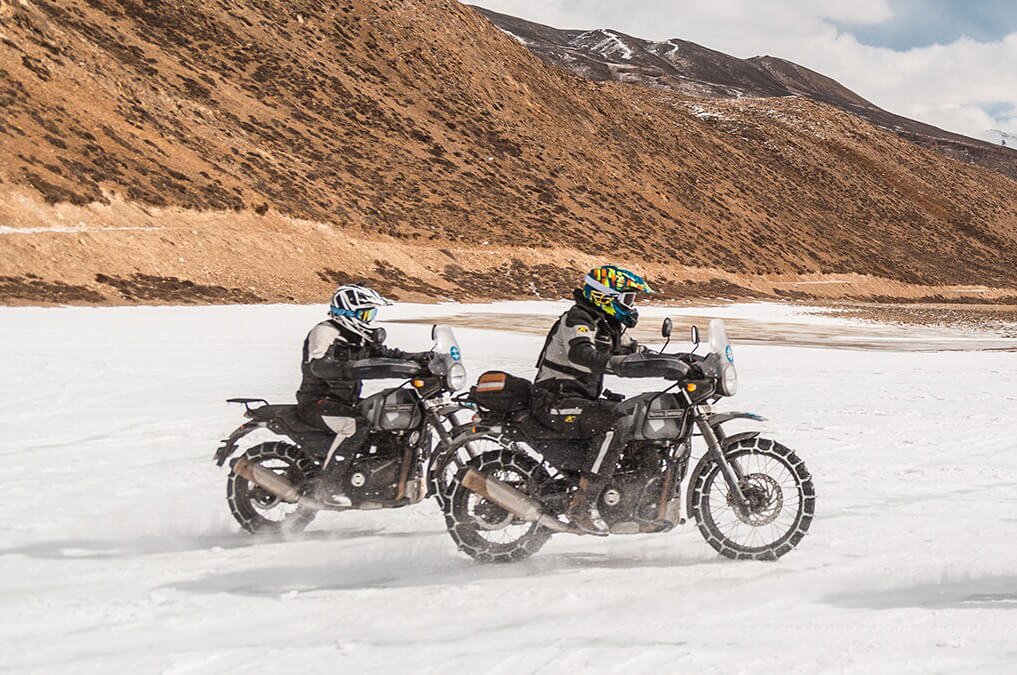
two men ride motorcycles in the winter snow (Source: Royal Enfield)
Motorcycle Winter Riding Tips FAQS
How cold is too cold to ride a motorcycle?
When temperatures drop below freezing, around 32°F (0°C), due to the potential for ice on the roads. Riding a motorcycle under this temperature will become risky.
The wind chill can make it feel even colder, increasing the risk of frostbite and hypothermia. Besides, the motorbikes also become harder to handle as tires lose grip.
Some riders find anything below 40°F (4°C) uncomfortable without proper gear.
Ultimately, it's crucial to assess road conditions, your bike's capabilities, and your comfort level before deciding to ride in cold weather.
How long should I warm up my motorcycle in the winter?
In winter, warm up your motorcycle for about 1 to 5 minutes. This allows the engine oil to circulate properly, ensuring smoother performance.
Modern motorbikes generally don't need long warm-up times due to efficient fuel injection systems.
Just start the engine, let it idle briefly, and ride gently until it reaches optimal temperature. Besides, you should avoid revving the engine hard right away.
This practice helps prevent engine wear and ensures all components are ready for the cold ride ahead.
When should you not ride a motorcycle?
Avoid riding a motorcycle during severe weather conditions. For example, the heavy rain, snow, ice, or strong winds day, as these increase the risk of accidents.
Also, don't ride if you're feeling unwell, fatigued, or under the influence of alcohol or drugs. These will impair your reaction time and judgment.
Poor visibility, whether due to fog, heavy traffic, or nighttime darkness without proper lighting, is another reason to refrain.
Always prioritize safety and assess both your condition and the environment before deciding to ride.
Is it OK to leave a motorcycle outside in the winter?
Leaving a motorcycle outside in winter is not ideal, but it can be managed with precautions. Here are some tips you can follow:
- Use a high-quality, waterproof cover to protect it from snow, rain, and ice. Ensure the cover is breathable to prevent moisture buildup, which can lead to rust.
- Consider using a battery tender to maintain the charge
- Keep tires off the ground to prevent flat spots.
- Regularly check and lubricate moving parts to prevent corrosion.
- If possible, store the motorbike in a garage or sheltered area for better protection.
Does snow damage a motorcycle?
Snow itself doesn't directly damage a motorcycle, but it can lead to issues.
Moisture from melting snow can cause rust and corrosion, especially on exposed metal parts.
Besides, the salt used on roads to melt snow can also corrode metal and damage the bike's finish.
If a motorcycle is left in the snow without protection, the battery might drain faster due to cold temperatures.
To prevent damage, use a waterproof cover and regularly clean and lubricate the bike.
Do I need to winterize my motorcycle?
Yes, you should winterize your motorcycle if you’re not riding it during the winter months. This process protects it from damage caused by cold weather and inactivity.
Key steps include:
- Adding fuel stabilizer to prevent the gas from degrading
- Charging the battery or using a battery tender
- Changing the oil to avoid engine corrosion
- Clean and lubricate the chain
- Cover the bike with a breathable cover
- Ensure tires are properly inflated to prevent flat spots.
Conclusion
Riding a motorcycle in winter can be a rewarding experience, offering unique sights and a sense of adventure.
However, it requires careful preparation and a cautious mindset.
By following these motorcycle winter riding tips, you can enjoy winter rides safely and comfortably.
Remember, the key to successful winter riding lies in preparation, awareness, and adaptability. Stay safe and enjoy the journey!
Related reading:
Motorcycle Winter Storage Tips | 10 Must-Do Steps
5 Essential Tips For Riding A Motorcycle In Winter
How To Winterize A Motorcycle with 8 Steps
7 Best Motorcycle for Snow and Ice
2025 Best Cold-Weather Gear for Adventure Motorcycle Riding

With over 10 years of experience working on cars and trucks Item Training Supervisor Richard Reina is known around the office as one of our technical experts & real an "automobile person".
His rate of interest began, in his very own words, "at the age of two when his father educated him the distinction in between a Chevy and a Ford. Since then it's been cars regularly."
As a serious lover of practically all things with a motor Richard can address nearly any kind of inquiry related to car upkeep, fixing, or restoration & is a fact professional in electric motor background.
The Fodsports FX 60C is leading a revolution in the Bluetooth camera intercoms market. This 2025 newest intercom with camera by Fodsports is designed to enhance your riding experience. This device comes with advanced features like Bluetooth 5.4, 4K HD recording, 10-way intercom, and plenty more. So it is clear that this device seamlessly blends […]
For motorcycle riding safety, effective stopping rocks because it has an influence on how fast you stop how stable you are, and how much control you get. Figuring out when and how to use the front and back brakes can really bump up your riding game and keep you safe. This guide is gonna show […]
As the electric vehicle Revolution accelerates the world of motorcycles, is no exception To be a landmark year for electric motorcycles with Cutting Edge. Technology, performance, and design advancements reshape the market. Electric motorcycles. Now, offers impressive, power, extended range, and Sleek designs. Whatever you need, the options in 2025 are more diverse and exciting […]
Motorcycle enthusiasts are a dedicated group. They enjoy the sense of liberation on the open highway, the excitement of riding, and the opportunity to display their beloved two-wheeled machines. But in today’s world, there’s a new debate revving up in the motorcycle community: gas vs. electric motorcycles. If you're an experienced rider or a beginner […]
Shopping for a motorcycle enthusiast can be tricky, especially if you’re not familiar with the gear and gadgets that make riding more enjoyable. Whether it’s the thrill of the ride, the joy of the open road, or the love for motorcycles themselves, finding the perfect Christmas gift can feel overwhelming. Here is a guide of […]

